| December 1937 Popular Mechanics |
 [Table of Contents] [Table of Contents]
Wax nostalgic about and learn from the history of early
mechanics and electronics. See articles from
Popular Mechanics,
published continuously since 1902. All copyrights hereby acknowledged.
|
What's the big deal
about television in Germany, you might ask? Today, it is no big deal, but in
1937 when this article appeared in Popular Mechanics magazine, it was.
Philo Farnsworth and
Vladimir Zworykin
had only recently demonstrated their all-electronics TV systems, and the battle
was on to decide whether the electromechanical systems that used rotating disks
and/or mirrors, or the electronic-only types would emerge victorious.
Communications standards committees were evaluating and hotly debating the pros
and cons of each. Multiple all-electronic television system schemes contended as
well. Each country and/or area in the world generated their own set of
standards, so manufacturers who serviced worldwide markets needed to accommodate
more than one system. Shortly after black-and-white (B&W) broadcasting finally
settled out, color TV thrust the industry and government regulators into another
round of contentious competition. This story reports on Germany's efforts to
bring television to its citizens - as it is preparing to start
World War II.
Television in Germany
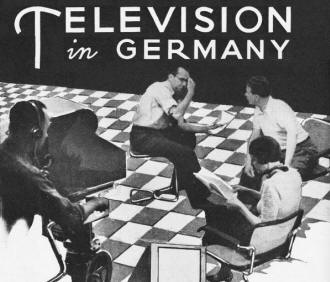
Preparing to shoot a scene for television.
Practical television receivers for the home are ready for Germany's radio fans
as the result of extensive experiment with various types of apparatus necessary
for transmission and reception. Latest developments include the announcement of
a combination of television, radio and phonographic reproduction in a single cabinet.
The radio is an all-wave receiver of the superheterodyne type. Another cabinet is
a projection-type television receiver, which uses a very small cathode-ray tube
and three mirrors and lenses to project a picture approximately thirteen by eighteen
inches upon a ground-glass screen. One model has a screen which folds down. A third
development is a projection-type receiver which reproduces on the screen a picture
about thirty-nine by forty-seven inches. Two other sizes of home receivers provide
for the picture to be viewed in a mirror. One employs a twelve-inch cathode-ray
tube, the other a nineteen-inch tube. An outstanding development, from a standpoint
of technique in transmission of television pictures, is a control board or mixing
panel which enables the operator to "fade" a film television program into a direct
pick-up.
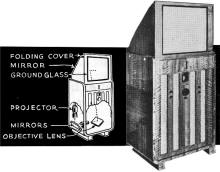
Photo and diagram of home receiver.
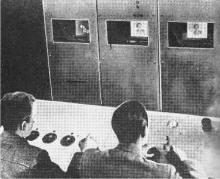
Regulating the quality of television in broadcasting station
by means of monitor panels.
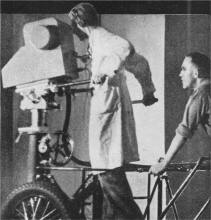
How television pictures are taken.
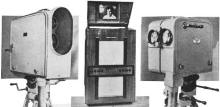
Left: Electron-tube camera for use in stage work. Center: Receiver
with nineteen-inch cathode-ray tube. Right: Small, easily portable television camera
for indoor and outdoor work.
Thus, this control makes it possible to eliminate abrupt changes in fading from
one program into another, adding to enjoyment of programs. Considerable progress
in development of a fast film process is re-ported. In this process, the scene first
is photographed by an ordinary motion-picture camera. Then the film is developed
quickly and the part intended for television is taken from the film and transmitted.
The process employs the high technique of modern motion-picture camera and newsreel.
One German company has perfected an intermediate film apparatus which is quite compact,
the whole device, including the film-developing equipment, being enclosed in a box
not much larger than a standard radio receiver. New film and chemicals for speedy
developing have been brought out for use with the apparatus so that the lag between
time of photographing the scene and of placing the development on the television
transmitter is ninety seconds.
Posted December 26, 2023
|